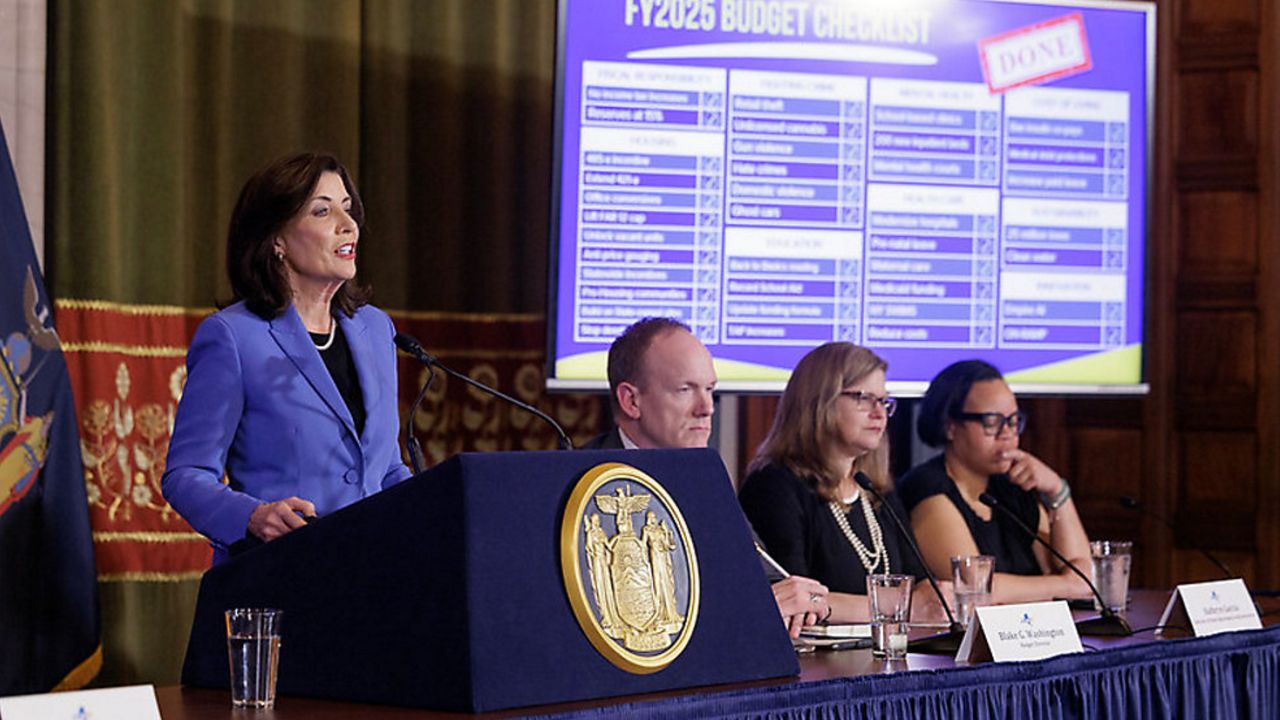First, inflation remained the biggest bottleneck for Americans even though official figures show that the underlying inflation level, which excludes energy and food prices, is at 4%.
Until the third quarter of 2023, the Federal Reserve (Central Bank or Fed) maintained its policy of raising interest rates to bring it to 5.25%-5.50%, the worst record in the last 22 years.
According to Fed Chairman Jerome Powell and the Central Bank’s Monetary Policy Committee, inflation has fallen consistently over the past 14 months, but consumers do not see that relief.
The decrease in the price of gasoline in the United States to an average value between 3 and 3.25 dollars, from more than 5 dollars on average in mid-2022, has not been able to compensate for the high prices of food, insurance, housing, health costs and most of the basic necessities in the country.
High cost of living
Americans not only continued to suffer from the high cost of living, but faced another year of increases, especially in food, insurance and housing costs.
Consumers paid average 2.9% more in food between November 2022 and the same month in 2023, according to a report on the Consumer Price Index (CPI) from the Bureau of Labor Statistics.
But already in 2022 prices had increased by 10.6 average Over the previous year.
Spending per person in a restaurant rose by 5.3%, while for meals (takeaway only) the figure rose by over 6%.
The cost of food production also rose 4.1%, according to the US Department of Agriculture.
The homes
The dream of owning a home in the United States became further distant for many in 2023 under the Joe Biden administration, while average monthly mortgage payments doubled compared to their value in 2020
With interest rates exceeding 7% and 8%, along with rising home prices, aspiring buyers were faced with one of the most unaffordable markets in recent times.
One analysis indicated that opting to rent (also an option whose prices have nearly tripled) might make more financial sense, as new leases averaged about $1,000 less per month than the cost of mortgage loans.
The study by real estate investment firm CBRE illustrated a difficult reality: Average monthly payments for a new home skyrocketed to $3,322 in the third quarter of 2023, marking a staggering 90% increase from the end of 2020, when it was around the $1,746 before Biden took office.
This analysis, focused on a $430,000 home with a 30-year mortgage and a 10% down payment, underscores the seriousness of the situation.
Overall, the mortgage industry suffered another year of decline with steep and systemic declines in sales continuing those of the previous annual period, in part due to high mortgage interest rates, lack of inventory, high prices and persistent economic uncertainty.
Cheque a cheque
More than 63% of US consumers will survive paycheck to paycheck in 2023; That is, his income barely allowed him to make ends meet.
The alarming trend should continue in 2024 and 2025, as economists have predicted.
The third year of Joe Biden’s government was no different from the rest due to the effects of his failed economic policies, which caused the country’s worst inflation in almost five decades due to (initial war) against the American oil companies. Initial because Biden was forced since mid-2022 to correct his confrontation and regulations in the extraction, production and refining of American crude oil, after inflation levels skyrocketed and in the face of the refusal of the Organization of the Petroleum Exporting Countries and its alliance (OPEC and OPEC+) to increase the quantities of “black gold” on the world market, with the purpose of bringing down fuel prices.
Although gasoline prices are not cheap, have fallen, thanks to record US oil production of 13.3 million barrels of crude oil per day on average, an essential factor in reducing inflation last year, but not to the level reported by the Biden government. Economists and independent entities consider that the current inflation figure far exceeds 4%.
However, what is good news, for Biden it is a pre-election whirlwind due to his idealistic promise of transition from fossil fuels towards so-called “clean energy” and the “destruction of the American oil industry.” In practice, the White House has done the opposite and large companies have increased their power and expansion, under criticism from environmentalists and radical left-wing groups that call for the eradication of oil, gas, coal and other derivatives.
Budget
The fights over the budget in Congress in Washington and over the United States debt ceiling, with Republican control in the House of Representatives, marked a brake on the Biden administration’s waste of funds in relation to its policy abroad, based on the delivery of money to entities, governments and non-governmental organizations along with the wars in Ukraine, Israel and China’s threats to Taiwan.
In 2022, the US public debt was 30 trillion dollars (trillions in English). After the end of 2023, the amount was around 34 trillion, a record figure in the history of the nation, when a new threat of paralysis of the federal government as part of a temporary budget agreement is still latent.
In order to finance part of the excessive spending on far-left partisan projects, the Biden government insisted in 2023 on passing (unsuccessfully) a historic tax increase on the middle class, small and medium-sized businesses, and the rich, which It would have slowed the economy even more and triggered unemployment.
As the only incentive, and against the purposes of the Central Bank, the labor market remained stable due to the more than 9 million jobs available throughout the country during 2023.
At this time and with little chance of coming to fruition, another Biden request for $106 billion is stalled in both Houses. Of that figure, more than $60,000 is destined for Ukraine.
The Republicans conditioned the approval of this new funding package on accurate and urgent measures from the White House against the chaos created on the southern border, throughout the Democratic mandate. And although there has been a slight reaction, the focus of recent agreements with Mexico continued to keep the border open under moderate measures.
Political analysts and conservative and independent legislators agree that the unprecedented crisis at the border, fomented by Biden and the far left, goes beyond a humanitarian crisis; It is a national security crisis.
Automotive strike
Another of the negative economic indicators in 2023 was the industrial sector with a historic 14-month contraction that began at the end of 2022. During that period, the score that reveals growth or decrease has been above 46 points on average, when the data by Below 50 points denotes a notable slowdown.
For its part, the automotive industry suffered the worst employee strike in its history with a paralysis of almost two months and several billion losses in the three main American companies: Ford, General Motors and Stellantis.
The strike carried out by the United Auto Workers (UAW) union simultaneously paralyzed factories and parts distribution centers of the three manufacturers. Never before has a union strike in this industry been carried out simultaneously.
In the first two quarters of 2023, massive layoffs continued in large technology companies, mainly due to the drastic drop in shares on Wall Street since mid-2022, among other causes.
Wave of closures
In the retail and service sectors, a wave of closures went unnoticed in the mainstream left-wing media.
Large restaurant chains, pharmacies and other companies closed thousands of establishments in 2023 as part of a readjustment of their finances in the face of the slowdown in consumption due to high prices, judicial favoritism to organized crime along with theft and vandalism in private businesses, especially in states governed by Democrats.
Since 2021, the CVS Health pharmacy chain was forced to close almost 1,000 stores; The data represents more than 9% of pharmacies in the US.
Another pharmaceutical retailer Rite Aid also cut more than 60 stores to reduce costs, while the legendary company Macy’s lowered the curtains on more than 100 stores from 2021 to 2023.
During the Biden administration, well-known retailers such as Walmart, Starbucks, Nordstrom and others have had to close most of their stores in the nation’s large cities due to insecurity and difficulties in finding employees.
More than 20 CEOs of American chains sent Congress in Washington a letter requesting measures to address the “growing impact of organized crime against businesses, employees and retail communities.” Among the signatories of the document were executives from Home Depot, Best Buy and CVS.
Between 2021 and 2023, restaurant chains have collapsed at high speed.
The extensive list includes Burger King, McDonald’s, Red Lobster, Hard Rock Cafe. They are followed by Ihop, founded in 1958, which has already closed more than 200 stores and almost half of them in the last 30 months; Applebee’s, Chipotle, the pizza chain, Sbarro; Hot Pizza, Hooters; Buffalo Wild Wins, Taco Bell, Cheesecake Factory, BJ’S, TGI Fridays and Subways, the largest fast food chain in the US that has had to close 35% of its locations
In this way, 2023 closed for the US economy, which analysts aligned with the White House say is solid. Resistant yes, because it has resisted the consequences of the disastrous economic policies of the Biden administration, with a very high cost for the vast majority of the American people.
(email protected)






